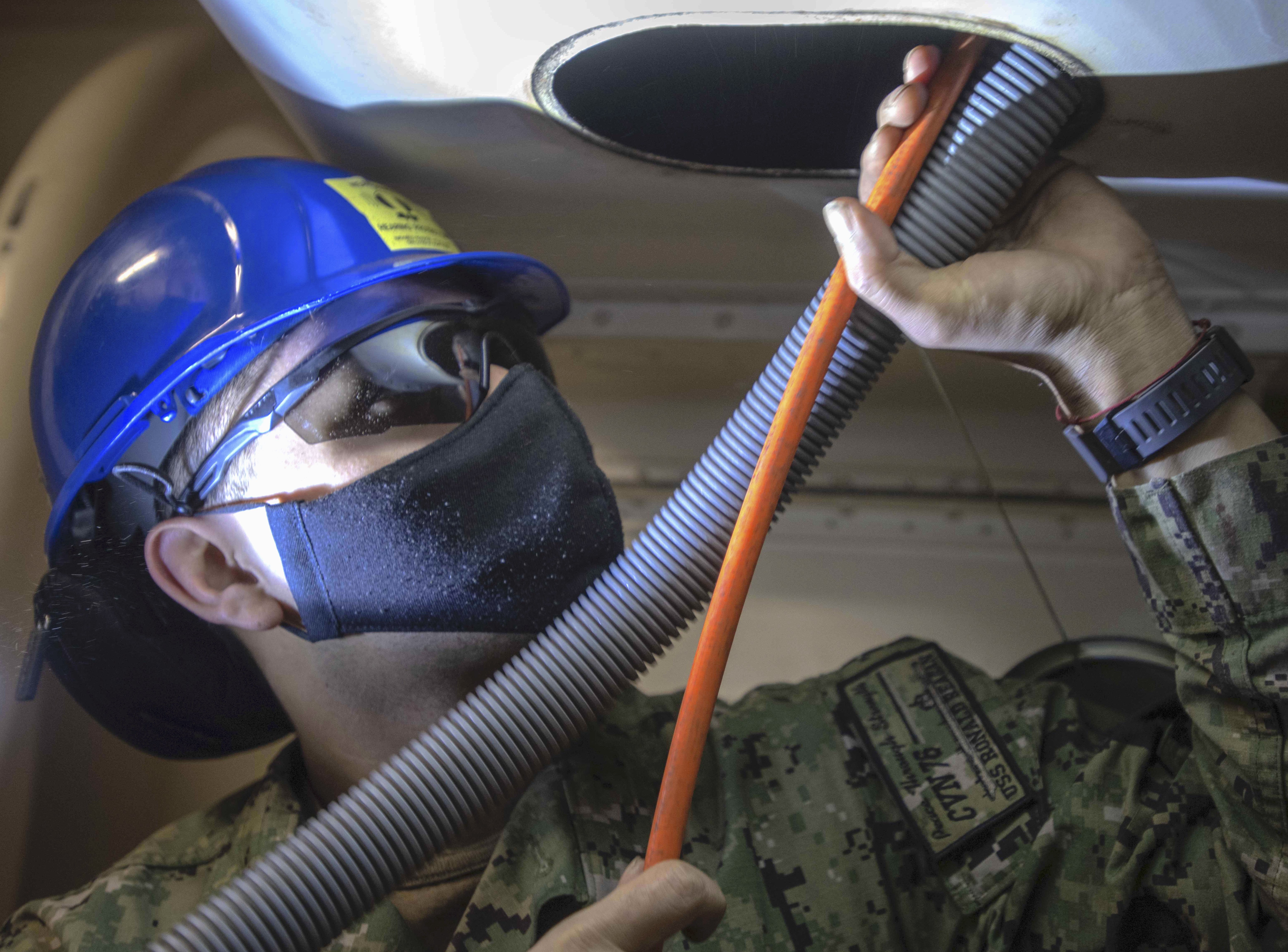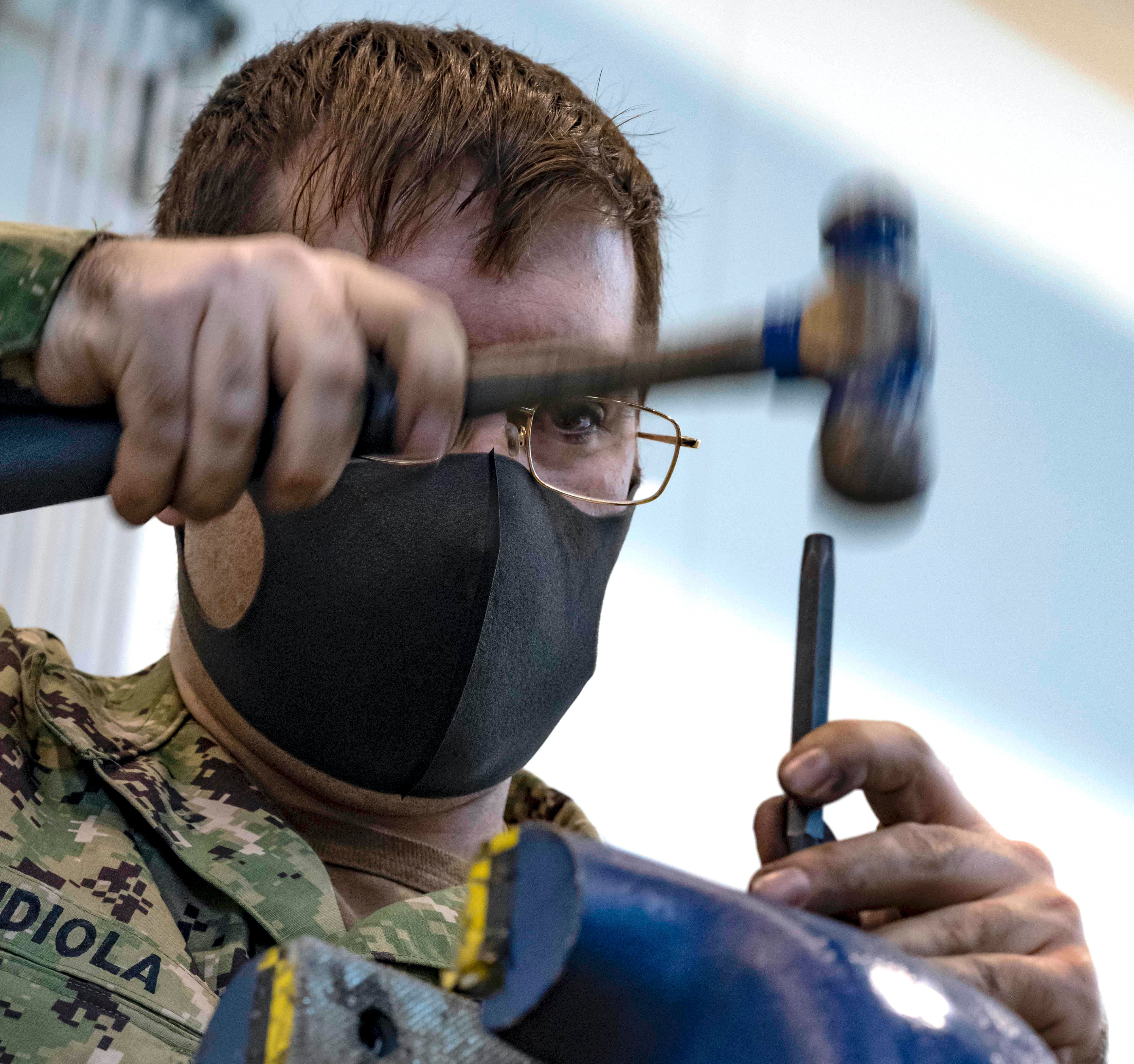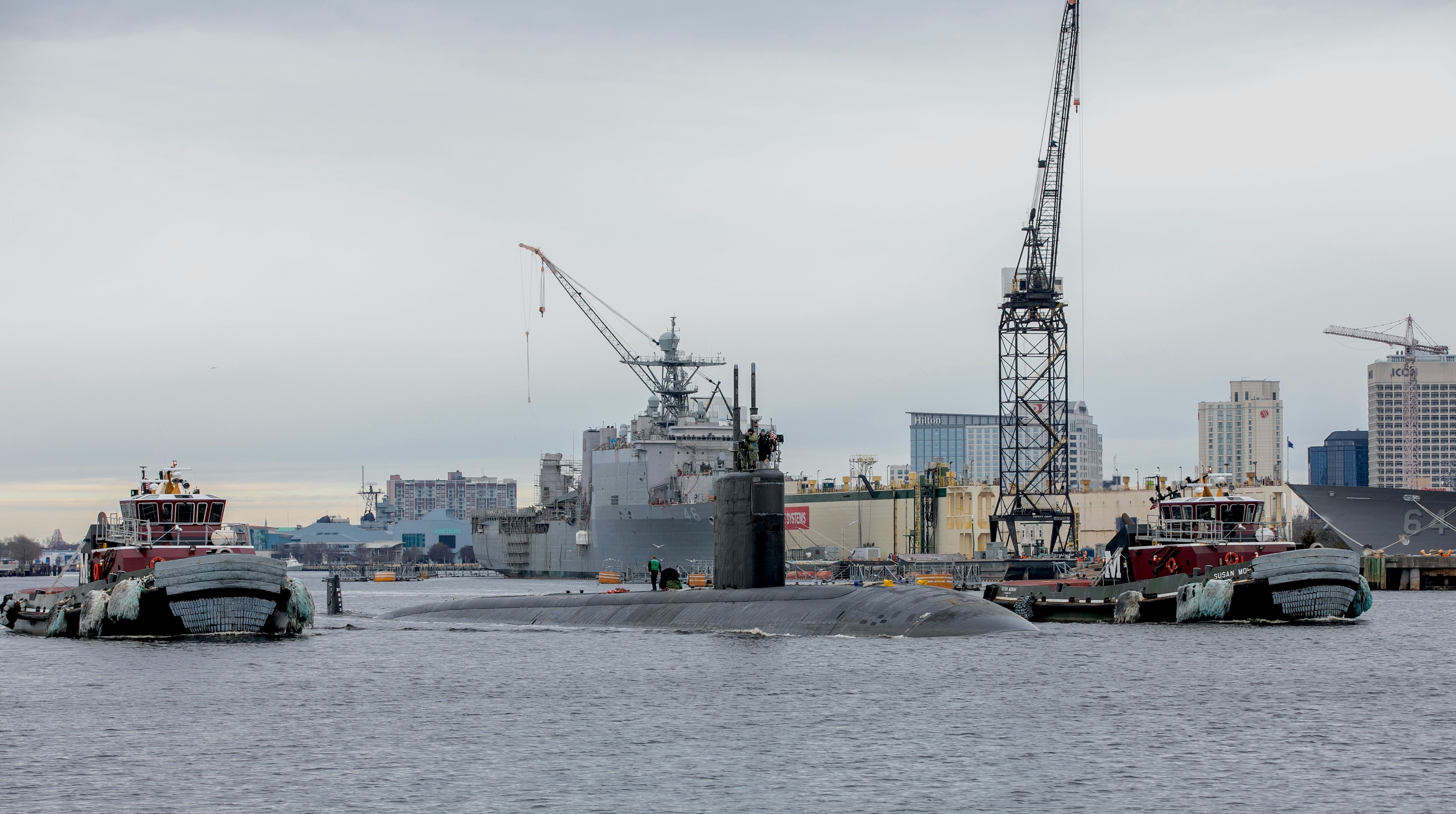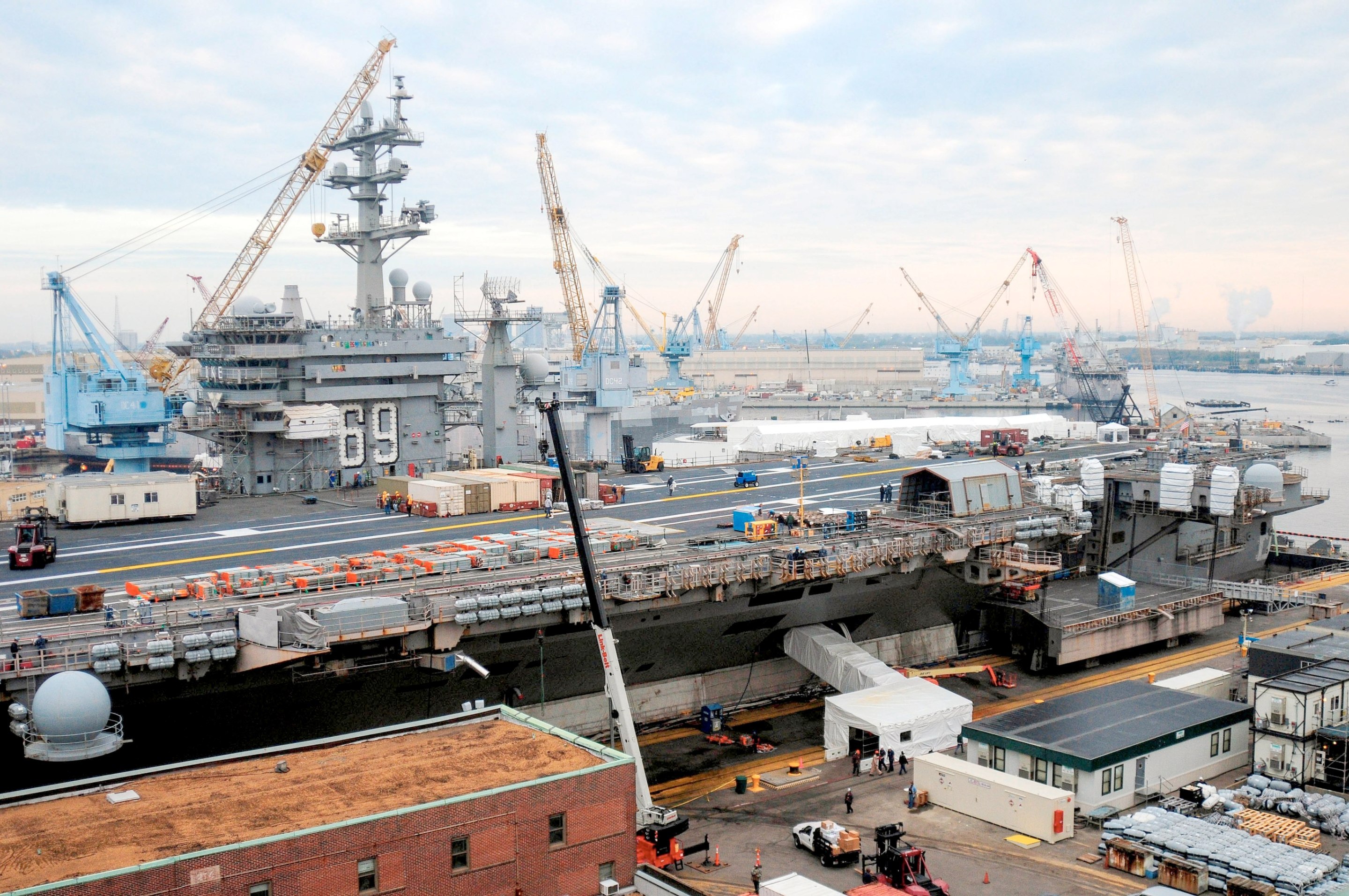
As the Navy expands the number of two data-driven programs that generate better readiness, there’s increasing support at the deck plate level to apply these principles across the fleet, the vice chief of naval operations told USNI News.
Adm. Bill Lescher said the Performance to Plan (P2P) and Naval Sustainment System (NSS) programs together have helped the Navy let the data guide them to changes that could generate the biggest boost to performance. Though the Navy has seven formal P2P programs and three associated NSS programs today, Lescher said the “get real” and “get better” mindset is percolating up and down the chain of command and inspiring a lot of unit commanders to reach out about applying the principles to improve their unit performance as well.
“It’ll be a pull and not a push because people want to do better,” Lescher said of the increasing ground-level interest in P2P and NSS. Though he noted that the default response to poor performance metrics can be “just give us some more inputs” — money, people, parts — “and we’ll get it done. Versus, people increasingly see that status quo performance is not either performing to plan, to what we think we’ve said, or to what we think we need. And so people want to get better, and I clearly see this. And so when we show quick wins with this, we show success, the people who want the progress will do it.”
Lescher pointed to aviation as the first big win in this effort that dates back to late 2017.
“We’ve been, in terms of force generation in F-18s, at 250 to 255 mission capable jets for about 10 years, which is noteworthy when the requirement was 341,” he said.
Then-Defense Secretary James Mattis in 2018 challenged the Navy and Air Force to reach 80-percent mission capable in their jet fleets. Lescher said “the Navy behavior prior to P2P structure would have been, ‘you go buy all the parts you can. You go buy all the people you can in the depots. You go buy all the capacity you can in repair velocity, and let’s see where we end up.’ But we had a different tool now: we had the ability to be predictive.”
Working with CNA, “we said, ‘hey, we have a digital ability to be predictive on our readiness. As a thought experiment, let’s crank all the most consequential drivers of F-18 mission capable readiness to 100 percent,’ which, of course, is completely different than actually achieving that. But the thought experiment showed, the digital model showed that we could crank all the drivers of F-18 readiness to our self-talk of 100-percent input and we would not get there,” he continued.
“So this is what led to the get better. So the get real is being able to be predictive, understand capability. Get better was, we need to fundamentally change our process capabilities, the transfer function between inputs and outcomes. And that’s where the related transformation engine of Naval Sustainment System comes into place, where we worked with industry leaders and thoughtful consultants on the deck plate to help us understand what right looks like in terms of world-class performance in the depots, in the O-level, to move the needle.”
Lescher described the P2P piece as finding the root cause of current performance and a “relentless hunt for leverage,” or the levers that would make the biggest difference in achieving better performance. NSS is a follow-on effort that brings in experts from industry or elsewhere to use their own best practices and lessons learned to help the Navy address those specific issues identified in P2P.
“We swarmed this hard, and … we leveraged insights from airlines,” he said, including adapting their idea of a “maintenance ops center aircraft on ground cell, MOC AOG. We attacked the velocity of maintenance in the squadrons at the organizational level, and we put in playbooks that compressed the time to execute the longest-duration scheduled maintenance, which was an 84-day check, from over 10 days to three days. And we understood from benchmarking world-class, major repair and overhaul facilities, including in Seattle, what it looked like to be world-class in depots. And so over 2019, after 10 years of 250 to 255 jets mission capable, [then-Commander of Naval Air Forces Vice Adm. DeWolfe Miller] and the team drove that to 341. And most impressively, we have sustained that number through COVID, and that reflects, really, the power of that learning.”

Lescher said he was particularly impressed with the aviation example because sequestration budget cuts earlier in the decade had hit aviation spares and depots particularly hard, and it would have been easy to just ask for more money for parts and people. Instead, he said, “when we did the analysis on the journey afterwards, over half of that improvement to 341 came from two process improvements: the MOC AOG, that was over a third. That fundamental process improvement, just changing the way we approached it. Another 20 percent was the velocity we brought into the O-level using the 84-day check playbooks. So over half of what had been stagnated for 10 years came from thoughtfully understanding process capabilities, world-class processes.”
Next, Lescher said, was tacking destroyer maintenance availabilities at private shipyards, which had been running long for many years.
“The get real piece of that was to understand what is the actual capability of our depots to achieve throughput in doing depot maintenance on destroyers. That get real journey culminated with a change to the [Naval Sea Systems Command] duration estimates,” so that the ships could realistically finish their maintenance availabilities on time — even if on a longer timeline — and be available to fleet commanders for operations on a predictable basis.
“The get better piece, again, was to bring in some understanding of root cause and leverage, and so an intervention model in this case that identified four levers that within government control, that were executable by the government, that showed the ability to decrease throughput time by up to 20 percent. That was the get better piece. So the journey in the private shipyards is in 2019 from over 7,000 days of maintenance delay to where we currently are, just under 4,000 days of maintenance delay, and forecasting to cut that further by more than half going into the next year.”
P2P was then expanded to include the Navy’s four public shipyards.
“Perform to plan, again, that relentless hunt for leverage, in the public shipyards is looking at the data defined by shop, by trade, by system. What’s the most consequential change we can make to increase throughput, decrease cycle time? Naval Sustainment System Shipyards, which is fairly new and recent, is now swarming that insight of leverage at the deckplate level to make changes in production control and other fundamental designs. Many basic lean concepts to drive change in the public shipyard outcomes,” Lescher said.
“It’s fairly nascent right now. I can tell you, I’m highly confident, based on what I see and based on what we’ve learned over three and a half years, that we are going to move the needle in a substantial way because we’ve got strong buy-in from the leaders of the four public shipyards. Dianna Wolfson in particular at Norfolk Naval — our largest shipyard — is strongly leading the change, and I’ve spent time talking to the influencers and leaders in the shipyards, and they want to leverage this learning as well.”
Lescher said the ultimate goal for NSS-Shipyard is to get aircraft carrier and submarine maintenance availabilities back to the duration outlined in the class maintenance plans. Today, the work is scheduled for a longer timeline and many still come out late; Lescher said the first goal is to start getting these ships out on time, and then to whittle the timelines back to where they should be according to class maintenance plans.

Another P2P effort with Naval Supply Systems Command (NAVSUP) led to the third formal NSS program, which Lescher said is “fairly new but driving some strong outcomes already working with the vendor base to reduce repair lead times, repair turnaround times” by 30 percent in some cases.
Today there are seven P2P efforts: aviation, surface ships, public shipyards, supply, undersea to address attack submarine operational availability, human resources and cyber. Three NSS programs have sprung out of those efforts — aviation, public shipyards and supply — to bring in outside experts that can share their own best practices and help the Navy see better outcomes by addressing specific procedures that just aren’t generating the speed and efficiency the Navy needs to keep a ready fleet.
The VCNO acknowledged some of this goes against intuition or Navy culture. For instance, he said P2P asks commanders to not only “find and embrace the red,” or the areas where performance is bad — but then to be transparent about those poorly performing areas so they can be fixed or elevated up to the next higher echelon for consideration. Lescher said commanders need to realize that elevating a challenge or highlighting a barrier to success isn’t a sign of failure or something that would come back to haunt them in a later performance review, but rather was a cornerstone of the P2P and NSS effort.
Three aspects of P2P that Lescher highlighted were its ability to clean up command and control relationships and designate a clear supported commander — who is accountable for ensuring better performance going forward — and the supporting commanders who can help make that possible; the data analysis and other tools that can help identify the biggest hurdles to success and predict how to fix them; and a constant drumbeat of conversation up and down the chain of command about progress and lessons learned from P2P and NSS, including quarterly reviews by Lescher at the four-star level to help stamp out any remaining barriers to success that lower echelons identify.
The four-star access was one of the early reasons leaders agreed to give P2P a try, Lescher joked, saying in the early days he had to seek out commands that he thought would benefit from P2P and work to convince them to give it a try. Now, he said, he speaks about P2P and NSS regularly when he travels throughout the fleet, and there’s often a line of commanders and lieutenant commanders who want to talk to him afterwards about how to apply P2P and its principles to their unit.
Lescher said information is available at p2p.navy.mil for all to access and that some lower-echelon commands will be selected to receive additional help and mentoring from his staff.
For those who do host formal P2P programs, they also have access to other flag officers who are working the same process in their commands and sharing lessons learned.
“We insist that every supported commander of a P2P attended every other supported commander’s P2P forum,” VCNO said.
“So when [Commander of Naval Submarine Forces Vice Adm.] Daryl Caudle is briefing P2P undersea, [Commander of Naval Air Forces Vice Adm.] Kenny Whitesell in aviation, [Commander of Naval Sea Systems Command Vice Adm.] Bill Galinis in shipyards, [Commander of Naval Surface Forces Vice Adm.] Roy Kitchener in surface, [Commander of Naval Supply Systems Command Rear Adm.] Pete Stamatopoulos in supply — they’re all in there, because we’re learning together.”

Lescher said he’s convinced P2P and NSS are here to stay, even when past efforts to improve performance or boost efficiency have faded away. His optimism is for several reasons: big Navy leadership is behind the effort; deckplate-level leadership is clamoring for the tools and support to bring P2P to their units; and, once a good process is put in place to fix a problem, it’s hard for high-performing naval officers to let their command slip back into the old way of doing things.
“It makes it easier to do our job well. It’s actually harder once you have a success — like aviation, to go back at this point from MOC AOG or the 84-day playbooks, or all this structure of the [Commander of Naval Air Forces’ Force Readiness Analytics Group]. It actually would be harder to deviate and go back to the old way of business, and then we would notice that our performance is getting worse,” Lescher said.
“And then I guess the last element of why it will stick is in fact, the structure we put in place. The C2, the tools, the cadence. The digital tools: people understand the power of that. And particularly when they see that it can be done in a focused way, and that it’s worked. The cadence of — we did the math, we’ve done since this started over 40 P2P forums at the three- and four-star level. About 20 Naval Sustainment Systems steering committee meetings, plenty of discussions at [Navy Flag Officer and Senior Executive Symposium], et cetera. As that structure becomes the way by which we problem solve and resolve barriers, then I think that’s got some long-lasting elements. … We’re developing a cohort of leaders that get it and are getting after this.”





